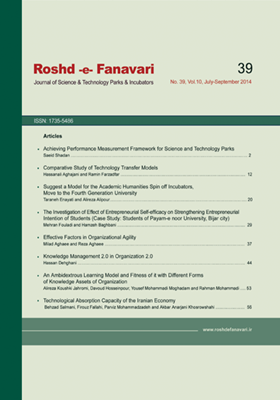Technological Absorption Capacity of the Iranian Economy
Subject Areas : انتقال فناوري و تجاريسازي پژوهشBehzad Salmani 1 * , Firuz Fatahi 2 , Parviz Mohammadzade 3 , Akbar Anrajani Khosroshahi 4
1 -
2 -
3 -
4 -
Keywords: Technology Absorption Hypothesis, Total Factor Productivity, R&D, Human Capital. ,
Abstract :
It is widely acknowledged that relying solely on physical capital and labor as main sources of the economic growth would cause countries to lag behind others in the process of sustainable development, and the productivity improvement through technological advancements is the only way that ensures the continued economic growth. So, it is important to study the economy’s potential of technological innovations and capacity of technology absorption in order to allocate the scarce recourses efficiently. Therefore, the main objective of this study is to investigate the capacity of technology absorption in the Iranian Economy. To that end, using data from the Iranian economy over the period 1347-1390, the technological absorption capability hypothesis of Teixeira and Fortuna (2010) has been tested. According to this hypothesis, the existence of adequate human capital could help the economy to absorb the technological spillovers caused by FDI, importing capital goods, and the collaborations between countries. Furthermore, this hypothesis states that the higher is the R&D expenditures, the higher is the technological absorption capability. Using the co-integration method of Johansen and Juselius (1990), it is found that the existence of adequate human capital in Iran has enhanced the technological absorption capability of the Iranian economy. However, the R&D expenditures have no significant effect on the absorption capability of the Iranian economy. In sum, the Iranian economy can benefit from the technological spillovers because of its capabilities to absorb the new technologies.
aaa

